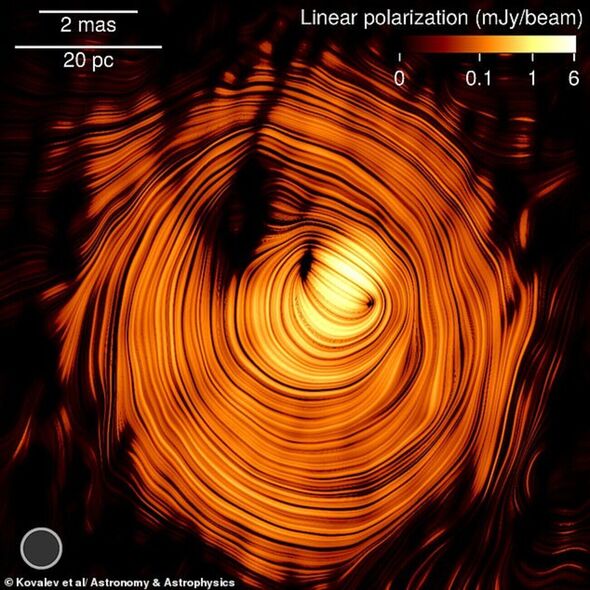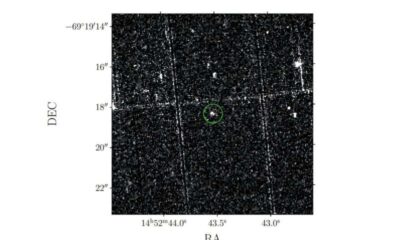Science
Cosmic Blazar Discovery Mirrors Fictional ‘Eye of Sauron’

A new astronomical discovery has revealed a deep space phenomenon resembling the fictional “Eye of Sauron” from J.R.R. Tolkien’s literary universe. Scientists have identified this object as the PKS 1424+240 blazar, a powerful cosmic jet located billions of light years away. Blazars are a type of galaxy that is energized by a supermassive black hole, and PKS 1424+240 stands out due to its unusual combination of brightness and slow apparent motion.
Researchers have long sought to understand the mechanics of blazars, and the findings related to PKS 1424+240 challenge existing theories. This particular blazar is noted for being one of the brightest while simultaneously exhibiting one of the slowest jet movements. This contradiction raises questions about the relationship between jet speed and luminosity, suggesting that factors beyond mere velocity contribute to the brightness observed.
Prolonged Observation Yields Insight
It took an extensive effort of 15 years to compile a comprehensive image of the jet. The researchers achieved this through the integration of high-resolution radio observations collected by the Very Long Baseline Array, which consists of ten radio telescopes strategically located across various regions. The lead author of the study, Yuri Kovalev from the Max Planck Institute for Radio Astronomy, expressed his astonishment, stating, “We have never seen anything quite like it—a near-perfect toroidal magnetic field with a jet, pointing straight at us.”
The alignment of this cosmic jet towards Earth amplifies its high-energy radio emissions significantly. Co-author Jack Livingston noted that this alignment boosts the brightness by a factor of 30 or more. He further explained that the jet’s slow appearance is a result of projection effects, which create an optical illusion of gradual movement.
Structure and Implications for Astronomy
Radio signals have indicated that the structure of the jet likely resembles a spiral or doughnut shape, facilitating the acceleration of particles to extreme energies. The research team’s findings have been documented in the journal Astronomy & Astrophysics, contributing valuable insights into the behavior of cosmic jets.
This discovery not only enhances our understanding of blazars but also illustrates the complexities of astronomical phenomena. As researchers continue to explore the universe, the findings from PKS 1424+240 may reshape existing theories about the nature of cosmic jets and their connection to the vast energies present in space.
By bridging the gap between fictional representations and tangible scientific discoveries, the study of this blazar challenges our understanding of the universe and sparks interest in the ongoing quest for knowledge in the field of astronomy.
-

 Entertainment2 weeks ago
Entertainment2 weeks agoKim Cattrall Posts Cryptic Message After HBO’s Sequel Cancellation
-

 Entertainment4 weeks ago
Entertainment4 weeks agoSpeculation Surrounds Home and Away as Cast Departures Mount
-

 Entertainment1 week ago
Entertainment1 week agoLas Culturistas Awards Shine with Iconic Moments and Star Power
-

 Entertainment2 weeks ago
Entertainment2 weeks agoMarkiplier Addresses AI Controversy During Livestream Response
-

 Politics1 month ago
Politics1 month agoPlane Crash at Southend Airport Claims Four Lives After Takeoff
-

 Lifestyle2 weeks ago
Lifestyle2 weeks agoTesco Slashes Prices on Viral Dresses in Summer Clearance Sale
-

 Top Stories1 month ago
Top Stories1 month agoAustralian Man Arrested for Alleged Damage to Stone of Destiny
-

 Sports2 weeks ago
Sports2 weeks agoCommunity Pays Tribute as Footballer Aaron Moffett Dies at 38
-

 Science2 weeks ago
Science2 weeks agoAstronomers Unveil New Long-Period Radio Transient ASKAP J1448−6856
-

 Sports1 month ago
Sports1 month agoSheffield United’s Young Talent Embraces Championship Opportunity
-

 Business1 month ago
Business1 month agoNew Study Links Economic Inequality to Lower Well-Being Globally
-

 Entertainment2 weeks ago
Entertainment2 weeks agoEmmerdale Characters Face Danger as Stabbing Shakes Village










